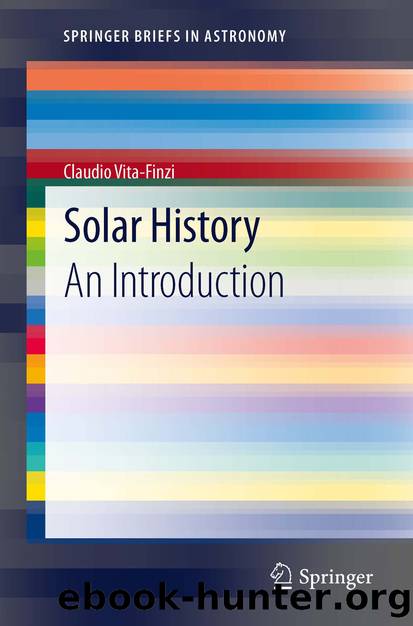Solar History by Claudio Vita-Finzi

Author:Claudio Vita-Finzi
Language: eng
Format: epub
Publisher: Springer Netherlands, Dordrecht
Secular Trends
The application of 14C to the dating of organic material had been founded on the assumption that atmospheric levels had remained constant; the discovery of deviations from normality, both as a product of fuel burning since the mid nineteenth century and as an inescapable feature of the carbon cycle, led to the search for a calibration curve with which to correct 14C dates to their calendric equivalent. The resulting plots were at first restricted to the last 12.4 cal kyr (the cal denoting that the age has been calibrated), the period for which dated tree-ring sequences could supply samples. Foraminifera and corals converted to the atmospheric equivalent with a site-specific marine reservoir correction later extended the sequence to the last 26 kyr; the present maximum attainable both by radiometric methods and by Accelerator Mass Spectrometry (AMS) is ~60,000 years but background and contamination problems generally point to 50,000 years as a more realistic limit. Calibration to calendar ages is now possible for the entire period [37, 38].
The 14C calibration curve shows that the atmospheric content of 14C fell from ~700 to ~100 % between 26,000 and 11,000 yr BP; there was a further fall of over 200 % after 12,000 yr BP [39]. The general decline (Fig. 5.2a) has been ascribed to a slow change of the geomagnetic dipole [40], presumably an increase in the VADM to account for reduced cosmogenic production. Fluctuations in the 14C curve are commonly detrended with the help of a sinusoidal curve, or by using a moving average, on the assumption that this allows the geomagnetic factor to be separated from the short-term (<200 years) solar signal. The procedure is not always made explicitly: long-term trends other than the 11-year variation were quietly removed by S. E. Forbush from widely used ground level ionization chamber readings for 1936–1968 and were thus deprived of secular significance [1].
Fig. 5.2 a Atmospheric 14C plot (‰); data from [39]; r2 = 0.97. b In situ 14C net concentration in ice crystals at Summit, Greenland; data from [41]; r2 = 0.85; c: Geomagnetic field intensity from core SOH-4, Big Island, Hawaii, based on measurements on 100 lava flows dated by potassium/argon (K/Ar) and spanning the last 42 kyr [49]; d: plot based on GEOMAGIA50 database from the entire world, although Eurasia, the SW USA and western South America dominate the map as do determinations for the last 7000 yr, after [50]. VADM = virtual axial dipole moment
Download
This site does not store any files on its server. We only index and link to content provided by other sites. Please contact the content providers to delete copyright contents if any and email us, we'll remove relevant links or contents immediately.
Tools of Titans by Timothy Ferriss(8301)
Turbulence by E. J. Noyes(7977)
Secrets of Antigravity Propulsion: Tesla, UFOs, and Classified Aerospace Technology by Ph.D. Paul A. Laviolette(5330)
Astrophysics for People in a Hurry by Neil DeGrasse Tyson(5149)
Room 212 by Kate Stewart(5066)
Design of Trajectory Optimization Approach for Space Maneuver Vehicle Skip Entry Problems by Runqi Chai & Al Savvaris & Antonios Tsourdos & Senchun Chai(5035)
Pale Blue Dot by Carl Sagan(4947)
The David Icke Guide to the Global Conspiracy (and how to end it) by David Icke(4653)
A Journey Through Divination and Astronomy by Publishing Pottermore(4363)
Goodbye Paradise(3760)
Apollo 8 by Jeffrey Kluger(3664)
COSMOS by Carl Sagan(3584)
Losing the Nobel Prize by Brian Keating(3518)
The Five People You Meet in Heaven by Mitch Albom(3514)
How to Read Water: Clues and Patterns from Puddles to the Sea (Natural Navigation) by Tristan Gooley(3430)
Brief Answers to the Big Questions by Stephen Hawking(3391)
How to Read Nature by Tristan Gooley(3289)
The Order of Time by Carlo Rovelli(3161)
A Brief History of Time by Stephen Hawking(2990)
